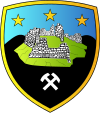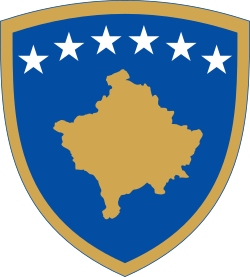Novo Brdo
Novo Brdo (Serbian Cyrillic: Ново Брдо), or Novobërda or Artana (Albanian: Novobërdë or Artanë), is a town and municipality located in the Pristina district of Kosovo[lower-alpha 1]. As of 2015, it has an estimated population of 9,670 inhabitants.
Novo Brdo | |
|---|---|
Town and municipality | |
 View on Novo Brdo | |
 Seal | |
 Location of the municipality of Novo Brdo | |
| Coordinates: 42°36′N 21°26′E | |
| Country | Kosovo[lower-alpha 1] |
| District | District of Pristina |
| Settlements | 32 |
| Government | |
| • Provisional president | Svetislav Ivanović (GIS) |
| Area | |
| • Total | 204.25 km2 (78.86 sq mi) |
| Elevation | 946 m (3,104 ft) |
| Population (2015) | |
| • Total | 9,670 |
| • Density | 47/km2 (120/sq mi) |
| est. | |
| Time zone | UTC+1 (CET) |
| • Summer (DST) | UTC+2 (CEST) |
| Postal code | 16000 |
| Area code(s) | +381(0)38 |
| Vehicle registration | 01 |
| Website | kk |
After the 2013 Brussels Agreement, the municipality became part of the Community of Serb Municipalities.
Name
In Serbian (and also English) "Novo Brdo" is used, literally meaning "New Hill". The name was derived from the medieval Serbian mining town of Novo Brdo. In Albanian, "Novobërdë" is used.[1]
History


Novo Brdo is an archaeological site.[2] Novo Brdo was mentioned with its present name in historical documents as early as 1326. Previously it was known as Novus Mons or Novamonte in Latin and as Nyeuberghe in Saxon texts. The famous Bulgarian scribe Vladislav the Grammarian was born here.
Novo Brdo was a metropolis at the time, with a huge medieval fortress built on the top of an extinct volcano cone, the remains of which can be visited today, and residential sections sprawling all around. In the outer wall of the fortress a large cross is visible, built into the stones. The castle, or fortress, was thought at one point to have dated back to the time of the Serbian Empire. The population at its height was estimated to exceed 6,720 people. At the first half of 15th century, Serbian Orthodox bishops of Lipljan resided in Novo Brdo. There were mines and smelting furnaces for iron, lead, gold and silver ores. Novo Brdo silver is known by its glam silver (argentum de glama, an alloy of silver with 1/6-1/3 gold). In 1450 the mines of Novo Brdo were producing about 6,000 kg of silver per year.
Novo Brdo was the last Serbian city to remain standing during the first invasion. In 1439 the capital of Smederevo fell and Serbia resisted until finally Novo Brdo fell in 1441. Novo Brdo was by treaty restored to the Serbs in 1443. The fortress (named in Turkish Nobırda) came under siege for forty days by the Ottomans, before capitulating and becoming occupied by the Ottomans on 1 June 1455. This event is described by Konstantin Mihailović from Ostrovica near Novo Brdo, who was taken by the Ottomans along with some 300 other boys to be trained as Janissaries. All of the higher ranking Serbian officials were executed after the castle fell, with the younger men and boys being taken captive to serve in the Ottoman Army, and some 700 young Serbian women and girls being taken to be wives to Ottoman commanders.
By the early 20th century, Novo Brdo's population dwindled, with most inhabitants moving to the more easily accessible area of Gnjilane. In 1999, with the entry into Kosovo of KFOR and the United Nations Interim Administration Mission in Kosovo (UNMIK), the area had a small military outpost occupied by US soldiers, as well as a station of International Police and Kosovo Police.
Economy
There are two lead and zinc mines operating on the territory of Novo Brdo: Kišnica and Novo Brdo.
Demographics
| Year | Pop. | ±% p.a. |
|---|---|---|
| 1948 | 3,960 | — |
| 1953 | 4,548 | +2.81% |
| 1961 | 5,153 | +1.57% |
| 1971 | 5,384 | +0.44% |
| 1981 | 4,984 | −0.77% |
| 1991 | 4,611 | −0.77% |
| 2011 | 6,729 | +1.91% |
| 2015 est. | 9,670 | +9.49% |
| Source: Division of Kosovo | ||
According to the last official census done in 2011, the city of Novo Brdo has a population of 6,729 inhabitants. However, in 2015 report by OSCE, the population of Novo Brdo municipality stands at 9,670 inhabitants, including internally displaced persons.[3] Municipality of Novo Brdo includes town and 31 villages.
Ethnic groups
The municipality of Novo Brdo is ethnically mixed, mostly consisting of Kosovo Serbs (60%), Albanians (39%) and other minorities.
The ethnic composition of the municipality of Novo Brdo, including IDPs:[3]
| Ethnic group | 1991 census | 2011 census | 2015 est. |
|---|---|---|---|
| Serbs | 2,666 | 3,122 | 5,802 |
| Albanians | 1,845 | 3,524 | 3,771 |
| Romani | - | 66 | 97 |
| Others | 100 | 14 | - |
| Total | 4,611 | 6,729 | 9,670 |
Notable people

- Stefan Milutin (c. 1253–1321), King of Serbia and founder of Novo Brdo Fortress
- Lazar of Serbia (c. 1329–15 June 1389) medieval Serbian prince, born in the Fortress of Prilepac near Novo Brdo
- Dragana of Serbia (c. 1380s – 1395), Empress consort of Bulgaria, born in the Fortress of Prilepac
- Jelena Balšić (1365/1366 – 1443) medieval Serbian noblewoman, born in the Fortress of Prilepac
- Gjergj Pelini (fl. 1436–died 1463), Catholic priest and diplomat of Skanderbeg and Venice.
- Dimitrije Kantakouzenos (c. 1435–after 1487), Serbian writer and poet
- Vladislav the Grammarian (fl. 1456–1479) Orthodox monk, writer, historian and theologian
Notes and references
- Notes
- Kosovo is the subject of a territorial dispute between the Republic of Kosovo and the Republic of Serbia. The Republic of Kosovo unilaterally declared independence on 17 February 2008, but Serbia continues to claim it as part of its own sovereign territory. The two governments began to normalise relations in 2013, as part of the 2013 Brussels Agreement. Kosovo is currently recognized as an independent state by 97 out of the 193 United Nations member states. In total, 112 UN member states recognized Kosovo at some point, of which 15 later withdrew their recognition.
- References
- See Republic of Kosovo municipality websites: "Municipality of Novo Brdo"., "Komuna e Novobërdës" (in Albanian).
- Rob Pickard (January 2008). Analysis and Reform of Cultural Heritage Policies in South-East Europe. Council of Europe. p. 67. ISBN 978-92-871-6265-6.
- "Novo Brdo/Novobërdë". osce.org. OSCE. Retrieved 19 August 2017.
External links
| Wikimedia Commons has media related to Novo Brdo. |
- Municipality of Novo Brdo
- "OSCE municipal profile of Novo Brdo" (PDF)., April 2008.
- Castle in Novo Brdo
- Novo Brdo youth and rural tourism network, local youth and rural tourism network. Arranges for bed and breakfast-houses and meals.
